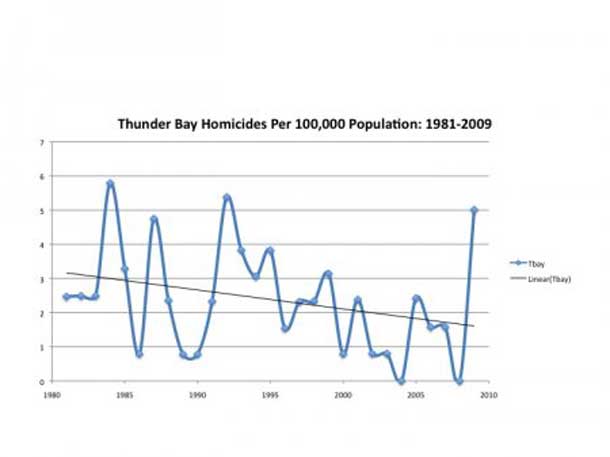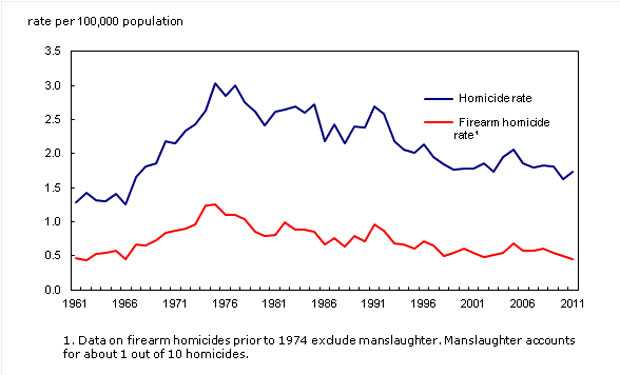THUNDER BAY – Editorial – Is crime in Thunder Bay getting worse? That is an interesting question especially given the public perception that there is more crime in general and more violent crime in particular.
One measure of violent crime is the homicide rate per 100,000 people.
As Figure 1 shows, aside from the spike in 2009, there has been a downward trend over time on data available from Statistics Canada for the 1981 to 2009 period. The average homicide rate in the 1980s was 2.8 per 100,000 population in the 1980s and 2.9 per 100,000 in the 1990s but the first decade of the 21st century has seen a drop to 1.5.
However, homicides are not the only type of violent crime.
Any crime that uses or threatens force is a violent crime. Figure 2 provides data using what Statistics Canada terms the Crime Severity Index, a relatively new statistical approach which constructs a measure of crime based on the severity of the criminal acts committed as well as their volume.
For the period 1998 to 2009 are presented an overall crime index, a violent crime index and a non-violent crime index. The results show that the overall crime index declined since 1998 and has remained relatively stable. The same pattern appears to characterize non-violent crime.
However, the violent crime index shows a decline from 1998 to 2003 and then an increase afterwards. Since 2003, the overall crime index in Thunder Bay has increased by 4.3 percent and the index for non-violent crime has declined 8.7 percent.
However, the index for violent crime is up 43.7 percent.
This represents a substantial increase and confirms the popular sentiment that the streets of Thunder Bay have become more mean and violent even if the average homicide rate is down.
Livio Di Matteo
 Livio Di Matteo is an economist in Thunder Bay, Ontario specializing in public policy, health economics, public finance and economic history. Livio Di Matteo is a graduate of the Fort William Collegiate Institute (1898-2005) whose school motto “Agimus Meliora” has served as a personal inspiration. Livio Di Matteo holds a PhD from McMaster University, an MA from the University of Western Ontario and an Honours BA from Lakehead University. He is Professor of Economics at Lakehead University where he has served since 1990. His research has explored the sustainability of provincial government health spending, historical wealth and asset holding and economic performance and institutions in Northwestern Ontario and the central North American economic region. His historical wealth research using census-linked probate records is funded by grants from the Social Sciences and Humanities Research Council of Canada. He has constructed, assembled and analyzed nearly 12,000 estate files for Ontario over the period 1870 to 1930. Livio Di Matteo writes and comments on public policy and his articles have appeared in the National Post, Toronto Star, the Winnipeg Free Press and Thunder Bay Chronicle-Journal and NetNewsledger.com. Livio Di Matteo has had an entry in Canadian Who’s Who since 1995.
Livio Di Matteo is an economist in Thunder Bay, Ontario specializing in public policy, health economics, public finance and economic history. Livio Di Matteo is a graduate of the Fort William Collegiate Institute (1898-2005) whose school motto “Agimus Meliora” has served as a personal inspiration. Livio Di Matteo holds a PhD from McMaster University, an MA from the University of Western Ontario and an Honours BA from Lakehead University. He is Professor of Economics at Lakehead University where he has served since 1990. His research has explored the sustainability of provincial government health spending, historical wealth and asset holding and economic performance and institutions in Northwestern Ontario and the central North American economic region. His historical wealth research using census-linked probate records is funded by grants from the Social Sciences and Humanities Research Council of Canada. He has constructed, assembled and analyzed nearly 12,000 estate files for Ontario over the period 1870 to 1930. Livio Di Matteo writes and comments on public policy and his articles have appeared in the National Post, Toronto Star, the Winnipeg Free Press and Thunder Bay Chronicle-Journal and NetNewsledger.com. Livio Di Matteo has had an entry in Canadian Who’s Who since 1995.
This article was originally posted on Livio Di Matteo’s NORTHERN ECONOMIST Blog at http://ldimatte.shawwebspace.ca.






